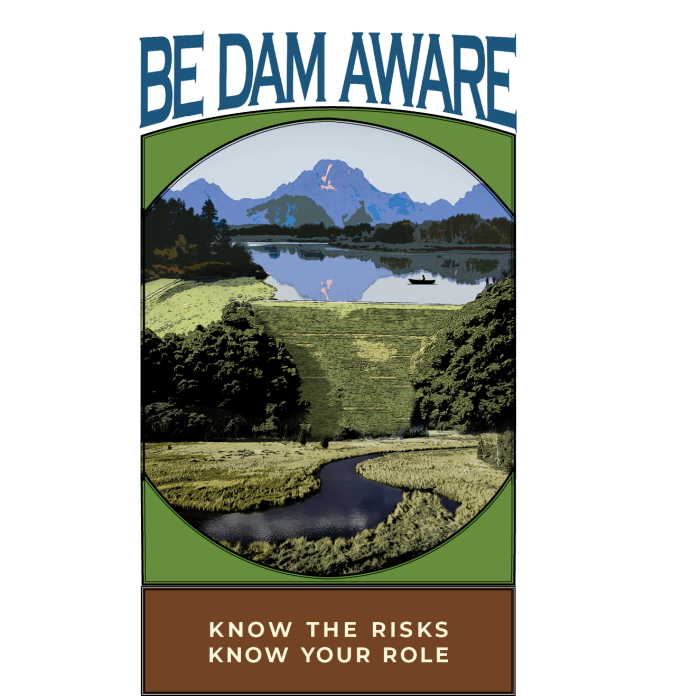
On May 31, 1889 the South Fork Dam near Johnstown, Pennsylvania - failed. Over 20,000,000 tons of water demolished the town killing over 2,200 citizens. Dam Safety Awareness Day was established to encourage everyone to do their part in keeping dams safe for the communities they serve.

EARTHEN DAMS
Earthen dams (pictured here) are also called ‘embankment’ dams. Like all dams, they act as a retaining wall to help control the flow of water and the amount of water that we have available. They are made with compacted soil, sand, clay and rock and blend with the landscape, unlike a gravity dam - which is monumental in size and construction.
GRAVITY DAMS
Recognizeable by their size and design, gravity dams are large concrete structures designed to hold back large amounts of water. In practice, size is proportional to resist the force of gravity.
DAMS are designed differently depending on the demands of the surrounding landscape and provide many benefits to the surrounding communities. They all serve a common purpose as ‘silent sentinels’ - to protect lives and property.
KNOW THE RISKS - KNOW YOUR ROLE

YOUTH AWARENESS
“We are kids that like playing near dams, but we’ve learned it’s not a good idea. Even if you are not in the water, you could slip and fall into the reservoir. I’m not just referring to big dams: even the small ones can be dangerous! That is why you should always have a parent with you when you are near a dam.”


COMMUNITIES
“Living near a dam, means we need to be ready to safeguard our family, friends and neighbors in the event of a dam emergency. This includes familiarizing ourselves with evacuation routes and signing up for emergency notification services and weather alerts. We found how to prepare at "Living with Dams" at DamSafety.org.”
Find out if you live near a dam at the National Inventory of Dams.

DAM OWNERS & SPONSORS
“I am the owner or sponsor of a dam, it is my responsibility to stay informed about any potential maintenance issues that may arise. As a precautionary measure, I have developed an emergency action plan or EAP, particularly for high-hazard dams, where a dam failure could result in loss of life. I found information to prepare my plan at DamSafety.org.”
Dam owners should work with their federal and state regulators to comply with safety standards. USDA’s Watershed REHAB program provides assistance to sponsors. Find information at Watershed Rehabilitation | Natural Resources Conservation Service (usda.gov).

WILDLIFE
Dams can improve wildlife habitat and provide food for migrating birds. They help retain water during heavy rains and ensure a steady water supply during times of drought. Reservoirs support a wide array of wildlife from fish to waterfowl and mammals. They provide food, shelter and breeding grounds for a variety of species.


RECREATION
“I enjoy recreational water activities such as swimming, kayaking, canoeing and boating at the nearby reservoir but I prioritize safety by carefully following all signs and barriers in the area. I found out how to stay safe at DamSafety.org.”
Water falling over a dam creates strong circulating currents beneath its surface. These currents are highly aerated and can trap people and objects against the dam’s face, making it practically impossible to escape. Even strong swimmers wearing life jackets can get caught, as can boats and kayaks.


LOCAL FARMS
“I am a farmer who benefits from a dam that is located near my farm. The dam provides a reliable water supply for irrigating my crops, especially during drought periods. However, I stay informed about water quality at Farmers.gov and have an emergency plan and preparedness procedures in place in case of an incident or dam failure. I found
information about preparedness through my local ag extension office.
Dams provide a reliable water source for agriculture, improve productivity, reduce drought vulnerability, and offer flood control to downstream farms.


USDA ShedTALK on DAM SAFETY
USDA Radio presents host Gary Crawford with the NRCS Dam Safety Coordinator/National Design Engineer - James Demby sharing information about the history of dams, dam safety and the importance of keeping eyes on our watershed infrastructure as they age.
WHAT ROLE DOES USDA PLAY IN DAM SAFETY?
AGRICULTURAL RESEARCH SERVICE (ARS)
Scientists and engineers at ARS provide the knowledge and tools needed to understand and predict the performance of earthen dams and spillways subjected to erosion during extreme weather events. ARS’ Agroclimate and Hydraulic Engineering Research Unit in Stillwater, OK and El Reno, OK, work closely with partners and Oklahoma State University to develop monitoring networks and engineering tools, including the DAM-TAGS project, and provide guidelines for the design, analysis, and rehabilitation of embankment dams, hydraulic structures, and channels in support of USDA Natural Resources Conservation Service (NRCS).
DAM-TAGS is a five-year project currently underway that combines research with cutting-edge technology to help develop cost-efficient ways to monitor watersheds.
FOREST SERVICE (FS)
The Forest Service owns and operates 1,500 of the 3,000 dams that currently reside on Forest Service lands. The remainder are privately owned and operated under a Special Use Permit or other authority. The agency provides an online education tool for dam owners and sponsors new to the role of performing dam safety inspections and assessments.
Assessing Dams and Impoundments: A Beginner’s Guide is a great resource for anyone that wants to learn more about dams, how they perform, potential hazards, how and how often to conduct inspections and clarifies responsibilities of dam ownership.
A Pocket Safety Guide is available as a quick reference for dam owners when assessing low hazard dams.
NATURAL RESOURCES CONSERVATION SERVICE (NRCS)
NRCS provides technical and financial assistance to local sponsors such as local government agencies, federally-recognized tribal organizations, or conservation districts, for watershed rehabilitation projects. NRCS Watershed Rehabilitation Program helps project sponsors rehabilitate aging dams that have reached the end of their design life and/or no longer meet federal or state safety criteria or performance standards. Since 1948, NRCS has assisted local sponsors in constructing over 11, 850 dams.
DamWatch, is a web-based tool to help dam owners/sponsors monitor and manage their dams. The application provides real-time monitoring of rainfall, snowmelt, stream flow, and seismic events that could pose a potential threat to dam safety.

